Part 2: Fixing Star Trek: Starship Creator
PC - Imergy, 2000
In which I turn 1998’s Star Trek: Starship Creator (27% - PC Games Magazine) into an immersive sim.
As we learned in Part 1, most of the failures of this game were in the missions and not a problem from the game itself. To recap, to fix the main problems we need to:
- Cut out boring travelling time during missions.
- Provide more interactivity, decisions, and ‘game’.
- Give better feedback on why things happen during missions.
- Tie missions together into a storyline.
1. Cut the Travelling
This is a simple fix, and the only reason I can think that it wasn’t done was to make the game longer or, if we’re being generous, to make the galaxy feel more vast and accurate. For all these missions we simply imagine the map as the whole galaxy, and set all our locations in a small area which only takes a short time to travel through. The player can zoom in so it makes no difference to the visuals.
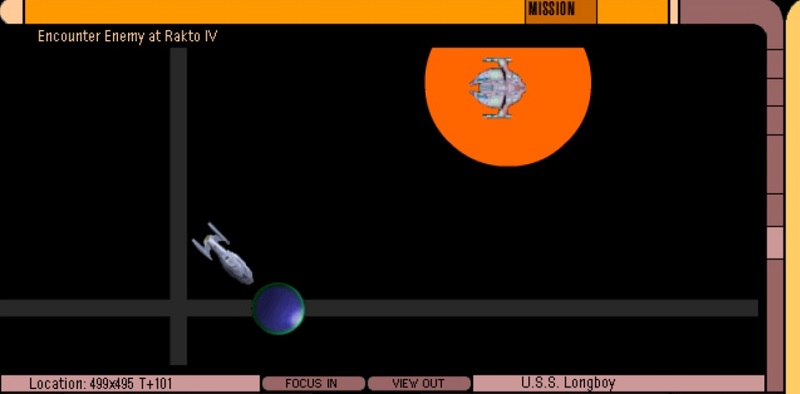
Meanwhile, we can insert some dialogue or player decisions into this travel time, as we know that one mission event will take place every ‘tick’ in the editor. In fact, if we need to do some exposition we can even increase the distances and make it part of the mission, which at least makes it interesting. The included missions usually have any dialogue take place while stationary, then long, silent periods of travel.
If your story really needs you to travel across the whole map, then it’s possible to create a ‘fast travel’ button. To do this we send an alert to the player asking them if they want to skip travel. If they click yes, use the teleport ship event (intended for simulating wormholes, I believe) to move the ship instantly to its destination coordinates. This is limited by the structure of the editor, so a very long busy mission might not be able to put one or more fast travels in, but even that would have been an easy fix and it’s criminal that the developers didn’t do this.
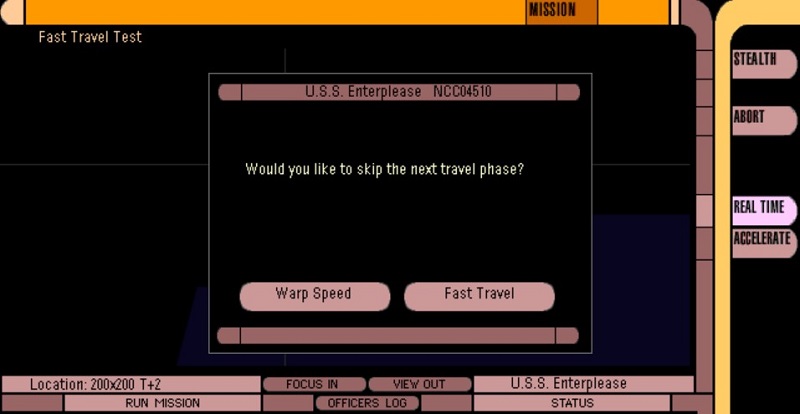
2. Making The Game A Game
This is where the fun begins!So how do we turn this game into a game? Let’s start with a story. I wanted to use the arboretum somehow, so I had an idea of a sick alien needing to go into the arboretum to heal in nature. Here’s the first part of the mission:
- Receive a distress call.
- Translate the distress call.
- Locate the alien ship.
- Travel to the alien ship.
We have two main tools for this. Firstly we use ‘checks’, which is an editor event that checks your ship or crew for whatever requirement you need. Then we have ‘decisions’. After you have used a check, you can use the decision event to decide what happens if the check passes or fails. You can see an example below.
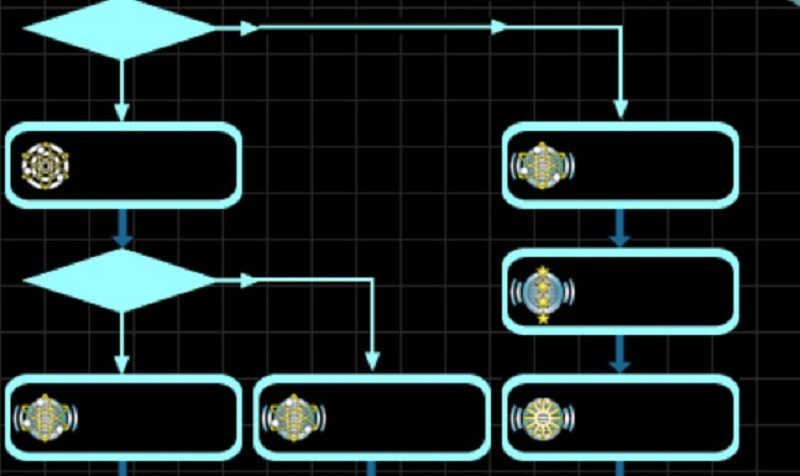
To make it more engaging we’re going to turn this into Star Trek: Deus Ex, and have multiple solutions to every step. When first attempting this, I had multiple solutions and checks, and went with the first successful one. However, since they were in parallel, to the player it just looked like it was one single check and the mission was too short (I never thought I would say that about Starship Creator). Instead we’ll solve problem number 3 (player feedback) as well, and have the crew discuss each option so it’s visible to the player.
Let’s take 3. Locate the alien ship as an example.
- The easiest solution is to have long range sensors to detect the ship in distress (check ship system).
- If you don’t have them, but you do have a skilled comms officer, they can triangulate the source of the signal manually (check comm officer skill).
- If you have neither, you can be given the option to scout the area using visual scans only (providing you have engines!), which would take some time, but succeed.
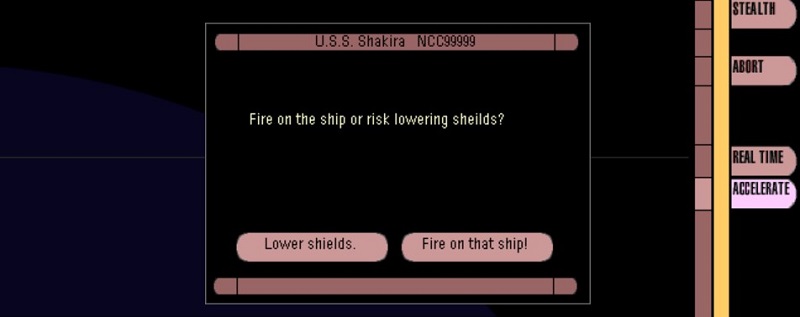
Three simple editor events, but given flavour by the text and technobabble provided back to the player. This also provides flexibility to the missions to avoid boring mission failures, and provides feedback on what is happening and why.
As we travel to the alien ship, we’ll put in some dialogue to keep the player entertained. When we arrive, we need to scan the ship. Again, we’ll have a few options depending on the ship’s systems and the ingenuity of the crew.
Now let’s give the player some agency. We detect a power surge from the unknown ship, it could be a weapon, but it could be something benign. Risk lowering your shields and beam the life form aboard, or fire on the vessel before it can attack? In this way you could even provide conversation options like a rudimentary RPG conversion wheel.
Now we have our first big story branch. If you fire on the vessel, an angry alien ship will arrive for you to deal with. The player can choose either combat or diplomacy and the story will end there: flee the battle, victory/defeat in battle, or a successful/failed first contact. Hopefully that's enough fun for a short mission.
One of the tenets of immersive sims is to provide alternatives rather than dead ends. A weak ship with no weapons but a skilled crew can have just as much fun as a fully kitted out ship, with multiple outcomes. The player only gets mission rewards for receiving the signal, finding the ship, and a successful first contact. Unfortunately the editor only lets you set a number of goals, and divides the reward between the number of successes, so you can’t set a smaller reward for an easier or less desired outcome.
The player can also be the one to help decide on these options instead of just using checks. For example if they want to be evil and destroy both alien ships, or nice and help the alien and use diplomacy for a peaceful outcome.
So far that’s 21 branching paths, about 150 events and 12 endings for this mission. This script is officially a better game than Deus Ex!
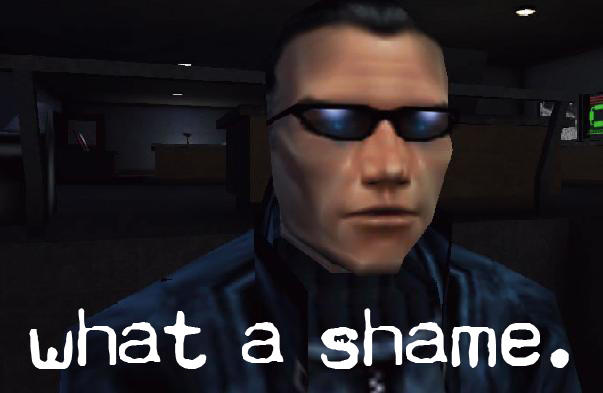
3. Better Feedback
Every time there is a relevant check on your ship or crew’s capabilities, we put a message or some dialogue in there to show it. Without this, the player has to go rooting through the long mission logs and find the information, where it has no context.
As mentioned, we can do some of this during travel times to make it less boring, and a bonus is that it’s more like a Star Trek episode if the player can see the crew discussing all the options and if you want even choose the best one.

The text system is not good, short messages, you can read the dialogue in a separate window or in the mission log if you don't catch it as it pops up on the screen, but providing this still greatly improves the fun from following the mission, and helps the player see what went wrong.
4. Campaign Storyline
Instead of making one huge mission, I’ve split this in half as a proof of concept for a series of missions.
There are two ways to do this, the first being the built-in function to link mission scripts together. This gets around some limitations on the structure as mentioned with the fast travel, instead of ending the mission, you use a link event and pass it the next script. In this way it could handle the multiple branching endings and give a different next mission based on for example if you had fired on the alien ship or used diplomacy.
Unfortunately I couldn’t get this to work with the sparse documentation that still exists 25 years after the fact, and none of the missions I found online did this either. So instead I just made a second mission, choosing one of the main endings that continued on. I guess you could name the missions as a choose your own adventure which would help take the endings into account.
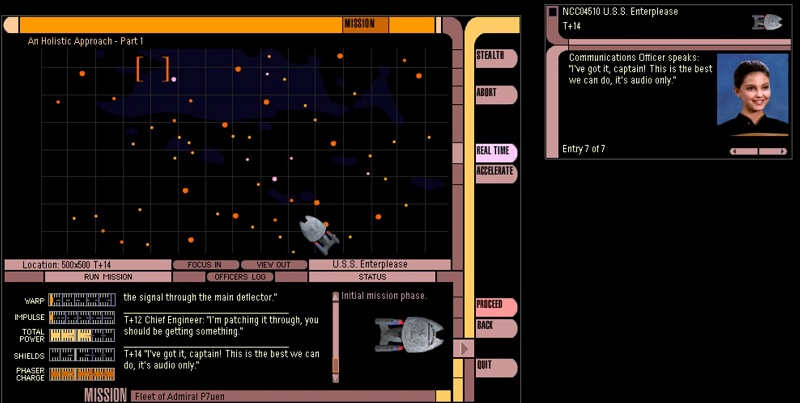
But there is still a way to have permanence over many missions. At the beginning of the script I simply instantiate the objects and ships to the map in the positions I want them. I could also do this with planets, anomalies, ships and everything else, for the entire galaxy map. With each mission starting like this, the map would be more alive and consistent. You can even hide objects until they come into sensor range.
To summarise this part of the mission, assuming you didn’t destroy the vessel:- Get the alien to your ship somehow.
- Diagnose the alien’s sickness.
- Heal the alien (or not).
As before, we provide a lot of options and feedback. If you have a highly skilled doctor they can diagnose that their patient needs to return to their natural habitat or they will die. Then, if your ship has an arboretum the patient can be sent there to recuperate. If you don’t have an arboretum, but you do have a holodeck, then you can simulate the environment there instead. But only if you have an exobiology lab to scan the alien so that the computer can approximate its natural environment, of course.
So playing through both missions we now have 28 branching paths, around 210 events and 17 endings for this mission.
The next mission, if I had the patience, could have you sending the patient back to its home planet. You could put a time limit for the crew to figure out the homeworld of the alien (say, through fixing the translators or scanning the warp trail of the ship), and then have a warp engine fast enough to get there in time before the alien died.You can see how this could be extended to a campaign length series of missions with fans making their own. Open source turn-based strategy The Battle for Wesnoth (2003) has a similar set of ‘official’ campaigns and user created ones and that is going strong after 20 years.
An Immersive Holodeck
Of course there are many ways the game could have been better, but I do find it baffling that if a few hours more time and effort had been taken on the missions themselves, this game’s trajectory could have been very different. The editor itself could do with some modern quality of life improvements to make it easier with branching paths in my opinion, and some basic trigger or variable events would have been good, but the core is already there. An immersive sim uses game systems and options don't have to be manually coded into the missions, but I think the point has been made.
Perhaps Imergy expected fans to do this for them, but there wasn’t enough to convince anyone to make the effort, and they didn’t set a good example of showing how much could be done with the officially included missions.
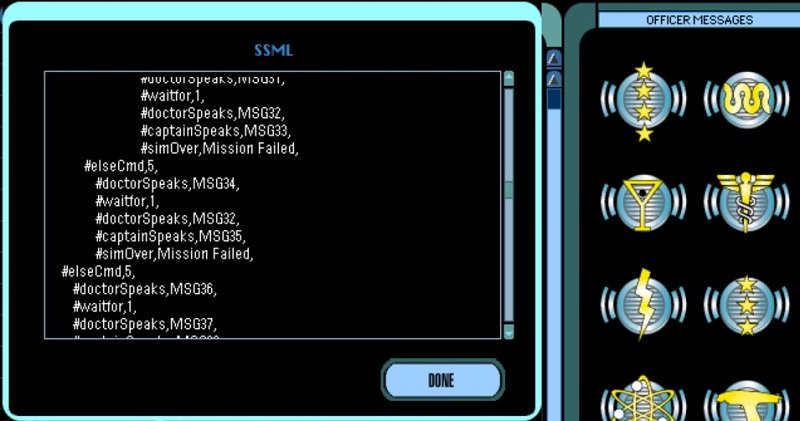
It’s very easy to create missions and make them very complex and involving, as we have seen. With better presentation in the game, it really could have been something close to a Star Trek episode maker. Maybe that would have fired up a few more imaginations than it did.
And so Starship Creator was forever consigned to the bargain bin, with one last gasp from some nerd 25 years later. Many old games developed a cult following and ongoing community, but this isn’t one of them. Despite trying them many times since 1998 to try and scratch a certain itch, I gained a lot of appreciation and respect for it now that I delved deeper into what it is capable of.
I should have done this a long time ago.Download the scripts below, right-click and "Save as" the text files:
- Download the ship:
- The USS Shakira (Akira Class) - NCC 04510
- Download the Missions:
- Episode 1: An Holistic Approach - Part 1”
- Episode 2: An Holistic Approach - Part 2”
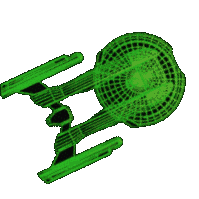
All game posts:
© P7uen 2023 | Base style css by EGGRAMEN 2020